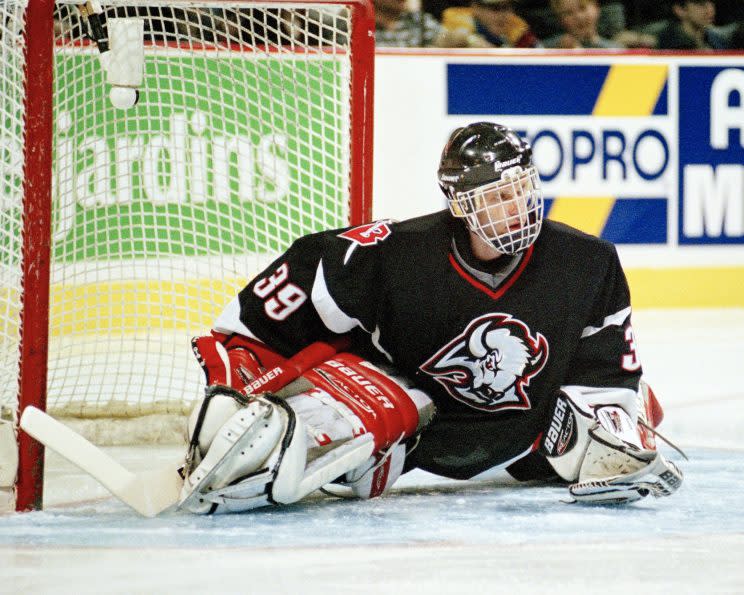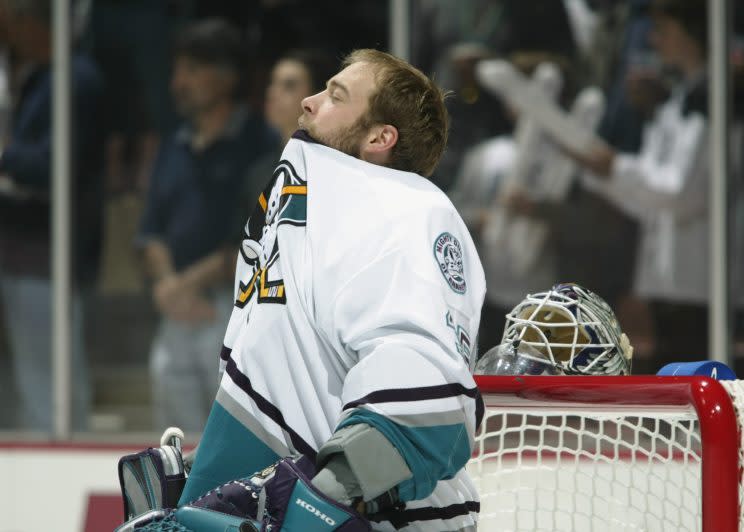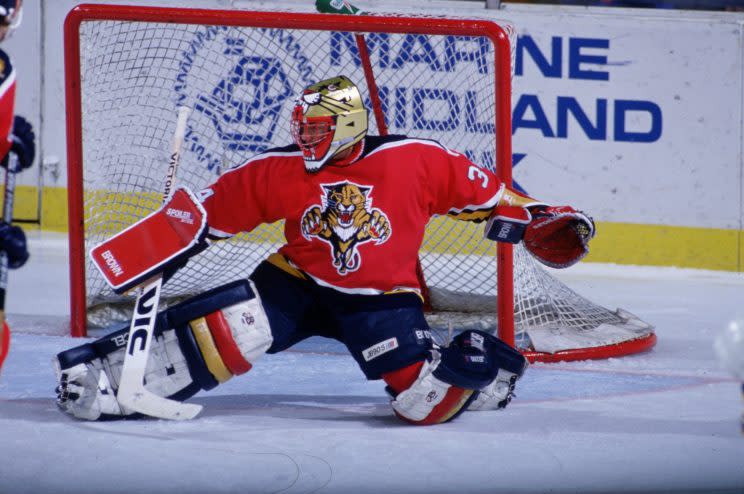Puck Lists: 11 goalies whose teams wasted their legendary performances

This week’s Puck List is actually a request.
Sparked by the likelihood that Ryan Miller, a goalie who ranks in the top-30 all-time for save percentage but is likely to miss the playoffs for the sixth time in his 12-year career, Andrew Ruestow wanted to know about some historically great goalies on historically bad teams.
Obviously Miller is going to be up there, but Dominik Hasek is the best goaltender of all time and didn’t get out of the first round of the postseason until he was 33 years old. Now that’s futility.
Anyway, I took the example nice kind cool Andrew provided — and by all means if you have requests, send ’em in via Twitter or the email address down below — and spun off it a bit (mainly because team winning percentages are hard to separate from goalie winning percentages).
Instead, here is a list of some of the best goaltending performances of all time that somehow did not result in a playoff berth.
The criteria here was simple: Goalies with save percentages of more than .920 (still the mark of a great goalie today) who racked up at least 25 losses and missed the playoffs. There were 11 in recent memory, but two poor souls made the list twice.
11 – Cory Schneider, 2014-15 (.925) and 2015-16 (.924)
In back-to-back seasons, Schneider’s save percentages were among the very best in the NHL, but the team in front of him was so bad that all he did was earn a handful of Vezina votes and cost the Devils some really high draft picks.
Schneider went .925 and .924 in these two seasons, respectively, which are some of the highest single-season numbers ever recorded. Schneider also appeared in 127 of New Jersey’s 164 games over those two seasons — that’s more than 77 percent — meaning that even as he faced tons and tons of shots (okay, just 3,600) the team in front of him straight-up couldn’t score enough.
In these two seasons, Schneider exceeded the league-average save percentage by 10 and then nine points.
10 – Tomas Vokoun, 2009-10 (.925) and 2010-11 (.920)
This one is going to register as a little controversial, not because Vokoun did it twice but because he did it in Florida.
The Panthers have long had a tendency to over-count shots on goal against, with just about anything the goaltender touches for any reason — whether it was going wide or not — counted as a save. We’ll encounter this problem again further down the list, but suffice it to say Vokoun’s actual numbers probably didn’t reach as high as the record books suggest.
Just going by the stats we have, though, Vokoun’s 2009-10 season (.925) ranks as the fourth-largest gap between a league-average save percentage (.911) and one recorded by a goalie whose team missed the playoffs.
9 – Miikka Kiprusoff, 2009-10 (.920)
This was right around the start of the Flames’ Going For It Era, when all rational observations of the Flames indicated they were starting to lose some of the power they had around the middle of the aughts.
That year was the first of five straight in which Calgary missed the playoffs, and it was one of just two more good seasons Kiprusoff had in the NHL — he was arguably the best goalie alive for three straight seasons, then had two down years, this one, another down year, another very good one, and crashed out completely.
This year, though, he beat the league average by nine points, which isn’t too shabby.
Like a lot of players of that era, the Flames just hung on a little longer than they should have.
8 – Cam Ward, 2010-11 (.923)
It’s easy to forget, but there was a stretch in the late 2000s and early 2010s where Ward was reliably great. This was his finest season.
He appeared in a whopping 74 games(!), starting 73 of them(!!!), but faced such a massive volume of shots that even as he led the league in goals against, he was also comfortably in the top-10 in save percentage. Fact is the Hurricanes weren’t all that good, and missed the postseason by two points despite Ward’s heroic effort, in which his save percentage was 10 points higher than league average.
He had one more good year after that (not counting this one), and it’s enough to make you wonder if the huge workload hurt him in the long run.
7 – Henrik Lundqvist, 2009-10 (.921)
It doesn’t take too much of an imagination-stretching effort to envision a Rangers team being so bad in front of Lundqvist that he doesn’t get them into the playoffs.
Lundqvist carried the water much as Ward did the next season (72 starts and one relief appearance) but the Rangers missed the playoffs by a single point because Olli Jokinen blew that shootout attempt in Game 82.
That’s as close as a goalie can get their team, because when you’re 10 points above the league average for 72 games and still don’t get in, that’s obviously not on you.
It’s on Olli Jokinen!
6 – Ilya Bryzgalov, 2007-08 (.920)
Bryzgalov got traded pretty early in the season, playing nine games for Anaheim before turning into a juggernaut in the desert.
He went .909 with the Ducks and then .921 with the Coyotes, putting him 12 points north of the NHL average for the season. That’s a tie for fifth-best on this list.
But even though he was that damn good, he still finished only four games above .500 in 55 appearances. That’s pretty good reason for him to be med.
5 – Nikolai Khabibulin, 2001-02 (.920)
Khabibulin was likewise 12 points above league-average in this season, which featured a relatively young version of the core that got this team a Stanley Cup two years later.
Brad Richards and Vinny Lecavalier were only 21. Vinny Prospal and Martin St. Louis were 26. In fact, everyone who scored at least 14 points for this team, with the exception of Dave Andreychuk, was under the age of 27.
Khabibulin was only 29 himself, and while the team in front of him didn’t score a lot (woof: only 178 goals in 82 games.) he kept it close most nights. They allowed just four goals over the league average because Khabibulin made 70 appearances.

4 – J.S. Giguere, 2001-02 (.920)
Another guy just a year before he fueled his team’s run at the Cup, Giguere cleared the league average by 12 points as well.
Giguere only made 53 appearances and finished five games below .500, which is tough to do when you’re a .920 goalie. Goes without saying, then: These Ducks were terrible. Maybe you chalk the high save percentage up to score effects, but when your team’s points leader finishes all 82 games at just 57 you have much bigger problems. What’s weird, though, is that the Ducks only got outshot by about 100 SOG for the whole season.
So I dunno. Like I said, bad team.
3 -Roberto Luongo, 2003-04 (.931)
Here’s the other Panthers guy where you’re like, “Whoa, .931?” Like, .931 would be a huge save percentage now. Basically it would guarantee you the Vezina and a playoff berth. Luongo won neither in 2003-04. In fact, he only won 20 games in 65 appearances despite a NINE THIRTY-ONE save percentage. It was 21 points higher than the league average.
That would seem to be impossible, but again the Panthers were almost certainly padding their SOG stats at both ends of the rink. So it’s tough to say for sure whether this number is legitimate, but if we’re saying it’s a whopping 21 points higher than the average goalie, then you have to agree that he had a great season regardless of what the number actually is.
2 – Dominik Hasek, 1995-96 (.920)
You knew he’d show up here.
For the vast majority of Hasek’s career the league save percentage was in the .890s and low .900s. And yet, he had multiple seasons of .930 hockey during that time. In 1998-99, he went .937, which is about the craziest stat in the world to me.
But this season in ’95-96 was a blip. He was “only” .920. “Only” 22 points above average. “Only” had 59 appearances.
The rest of the Sabres sucked that year. I will not forgive them.

1 – John Vanbiesbrouck, 1993-94 (.924)
Truly incredible season — albeit in Florida — to turn in a season 24 points north of the average. That’s the largest divide on the list.
And even if that number is inflated (probably it is) you have to keep in mind that the league-average goalie that season stopped .895. To even be north of .915 would be really incredible.
So yeah I’m taking the number with a grain of salt, but also: He was still unbelievable.
—
Ryan Lambert is a Puck Daddy columnist. His email is here and his Twitter is here.

 Yahoo Sport
Yahoo Sport 







































